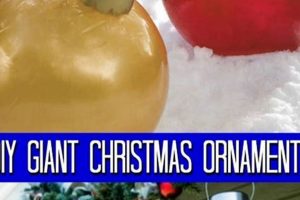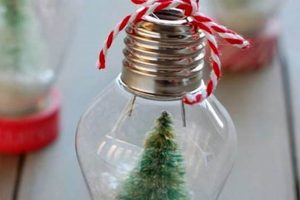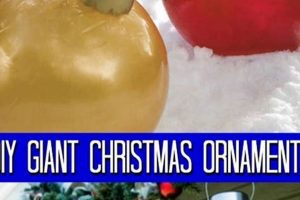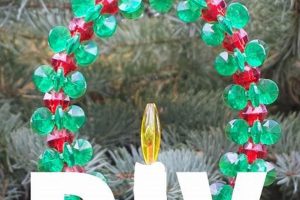The creation of personalized, old-fashioned holiday decorations offers an avenue for individuals to craft unique festive embellishments. This undertaking typically involves repurposing materials, replicating historical designs, or incorporating aged aesthetics into handcrafted items intended for seasonal display. Examples include ornaments fashioned from antique fabrics, repurposed buttons, or paper crafted to resemble aged ephemera.
The activity serves as a conduit for creative expression, allowing for the adaptation of traditional styles to individual preferences. Moreover, it fosters resourcefulness by encouraging the reuse of existing materials, potentially reducing waste and offering a cost-effective alternative to commercially produced decorations. The practice connects individuals to past eras, evoking a sense of nostalgia and reflecting earlier craft traditions through tangible, handmade objects.
The following sections will delve into specific techniques and material choices suitable for constructing such individualized festive dcor. Instructions and examples will illustrate methods for achieving an authentic vintage aesthetic in hand-made Christmas adornments. The subsequent discussion will also cover sources for inspiration and guidance in this creative pursuit.
Tips for Creating Personalized, Old-Fashioned Holiday Decorations
The following tips provide guidance for crafting decorations with an authentically aged and individualized appearance. Consideration of these points can contribute to the successful execution of desired design aesthetics.
Tip 1: Source Authentic Materials. Incorporate original vintage items such as antique lace, salvaged buttons, or fragments of old textiles. These elements inherently possess the patina and character of their age.
Tip 2: Replicate Historical Designs. Research historical ornament styles from desired eras and emulate their forms. Patterns and motifs from Victorian, Art Deco, or mid-century periods can provide inspiration.
Tip 3: Employ Aging Techniques. Artificially age paper, fabric, or other materials through staining with tea or coffee, distressing edges, or applying crackle medium to simulate the effects of time.
Tip 4: Consider Color Palettes. Limit color selections to muted or desaturated tones typical of the chosen vintage era. Avoid bright or neon shades that detract from an aged aesthetic.
Tip 5: Master Hand-Sewing and Crafting Techniques. Develop skills in basic sewing stitches, paper crafting, and other traditional techniques relevant to ornament construction. Refine craftsmanship for a higher-quality result.
Tip 6: Incorporate Found Objects. Transform everyday items like bottle caps, wire, or old beads into decorative elements. Repurposing objects contributes to a unique and sustainable approach.
Tip 7: Apply Consistent Aesthetic Principles. Maintain a consistent stylistic theme throughout the ornaments. Harmonious design choices strengthen the overall visual impact.
Following these guidelines can significantly enhance the authenticity and visual appeal of your handmade Christmas decorations, resulting in pieces that evoke a sense of nostalgia and timelessness.
The subsequent section will explore avenues for showcasing and preserving these crafted holiday treasures.
1. Authentic Material Sourcing
Authentic material sourcing represents a critical element in the successful creation of individualized, old-fashioned seasonal decorations. The character and history inherent in genuine vintage components directly influence the perceived authenticity of the finished ornament. Securing these materials often requires a dedicated search and a discerning eye.
- Antique Textile Acquisition
Sourcing fabrics from past eras provides a foundational element for vintage-inspired ornaments. Antique linens, lace remnants, and scraps of old quilts can be incorporated into ornament designs. The aged texture and patterns of these materials are difficult to replicate artificially, lending a distinct air of authenticity to the finished product. For example, using a fragment of a 1920s silk scarf as the central element of an ornament immediately grounds it in that historical period. The limited availability of such items necessitates resourceful acquisition strategies.
- Repurposed Button Utilization
Collections of vintage buttons, often found in estate sales or antique shops, represent a readily accessible source of authentic embellishments. Buttons from various decades reflect evolving styles and materials, offering a diverse palette for ornament design. Using bakelite buttons from the 1930s or glass buttons from the Victorian era can instantly communicate a specific historical aesthetic. The inherent variations and imperfections in vintage buttons contribute to the handmade and aged appearance.
- Salvaged Hardware Incorporation
Small metal components, such as old clock gears, furniture tacks, or jewelry findings, can be repurposed to add textural and visual interest to ornaments. These salvaged hardware pieces often possess a patina of age and wear that enhances the vintage aesthetic. For instance, incorporating a tarnished brass gear into a steampunk-inspired ornament connects it to a specific design subculture rooted in historical machinery. Safe handling practices are essential when working with salvaged metal items.
- Vintage Paper Ephemera Integration
Using fragments of antique sheet music, postcards, or greeting cards provides a direct link to the past. These paper ephemera items can be carefully incorporated into ornament designs, adding layers of historical context and visual intrigue. For example, decoupaging a vintage Christmas postcard onto a wooden ornament base immediately imbues it with a sense of nostalgia and authenticity. Preservation techniques are critical when working with fragile vintage paper.
The meticulous sourcing of authentic materials directly enhances the fidelity of old-fashioned Christmas ornaments. While artificial aging techniques can approximate a vintage aesthetic, the incorporation of genuinely aged elements elevates the ornaments to a higher level of historical credibility and visual appeal. Collectors and enthusiasts often prioritize ornaments that incorporate authentic vintage materials, recognizing their unique character and inherent value.
2. Historical Design Replication
Historical design replication is a central aspect of crafting individualized, old-fashioned holiday decorations. The process involves studying and reproducing decorative motifs, construction techniques, and aesthetic principles characteristic of specific historical periods, lending authenticity to the finished ornaments. Accurate replication requires research, attention to detail, and skillful execution.
- Victorian Era Ornament Motifs
Replicating Victorian-era ornaments involves incorporating specific materials and designs prevalent during the period. Common motifs include velvet ribbons, glass beads, metallic threads, and paper scraps depicting religious scenes, flowers, or cherubs. Ornaments often feature intricate beadwork, padded satin forms, and elaborate paper cutouts. Accurate replication necessitates sourcing materials resembling those available in the 19th century and mastering techniques like bead embroidery and paper quilling. The result captures the ornate and sentimental character of Victorian holiday decorations.
- Art Deco Geometric Patterns
Art Deco ornaments, popular in the 1920s and 1930s, are characterized by geometric patterns, streamlined shapes, and the use of materials such as metallic paint, mirrored glass, and stylized representations of natural forms. Replication involves recreating these geometric motifs using stencils, templates, or freehand techniques. Silver and gold tones are frequently employed, along with contrasting black accents. The effect is a sophisticated and modern aesthetic, reflecting the design sensibilities of the Art Deco period.
- Mid-Century Modern Ornament Simplicity
Mid-century modern ornaments, prevalent from the 1940s through the 1960s, often feature simple shapes, bright colors, and the use of materials like felt, plastic, and spun cotton. Replication involves recreating these clean, minimalist forms and employing a vibrant color palette. Common motifs include stylized stars, geometric trees, and abstract patterns. The overall aesthetic is characterized by its playful simplicity and optimistic outlook.
- Folk Art Ornament Traditions
Folk art ornaments represent a diverse range of regional traditions, each with its unique materials, techniques, and motifs. Replication requires understanding the specific cultural context and design principles associated with a particular folk art style. Examples include Scandinavian straw ornaments, Mexican tin ornaments, and Pennsylvania Dutch fraktur designs. Accurate replication involves mastering the traditional techniques and employing materials authentic to the chosen folk art tradition.
The successful replication of historical ornament designs contributes significantly to the creation of genuinely vintage-inspired holiday decorations. By accurately reproducing the materials, motifs, and techniques characteristic of specific historical periods, crafters can evoke a sense of nostalgia and authenticity. The resulting ornaments serve as tangible reminders of past eras and reflect a deep appreciation for historical design traditions.
3. Aging Technique Application
The application of aging techniques represents a pivotal process in the creation of handcrafted, vintage-inspired holiday ornaments. It seeks to artificially replicate the effects of time and wear, imbuing newly crafted objects with the patina and character of genuinely aged items. The deliberate use of these techniques is crucial in achieving an authentic vintage aesthetic.
- Tea and Coffee Staining
The immersion of paper, fabric, or wooden ornament components in solutions of tea or coffee imparts a subtle discoloration, mimicking the yellowing and browning that occurs naturally over decades of exposure to light and air. The intensity of the stain can be controlled by adjusting the concentration of the solution and the duration of immersion. This method is particularly effective for creating a convincing aged appearance on paper ephemera and fabric embellishments incorporated into the ornaments. Inconsistent application can lead to an artificial and unconvincing result; therefore, a nuanced approach is required.
- Distressing and Sanding
The strategic abrasion of ornament surfaces, particularly edges and corners, simulates the wear and tear that typically accumulates on objects subjected to prolonged handling and storage. This process, often achieved with sandpaper or abrasive pads, removes superficial layers of paint or finish, exposing underlying materials and creating a visual representation of age-related degradation. The controlled application of this technique is essential; excessive or random abrasion can produce an unnatural and visually jarring effect. The process is most effective on ornaments constructed from wood, metal, or layered paper products.
- Crackle Medium Application
The application of crackle medium to painted or varnished ornament surfaces induces a network of fine cracks as the medium dries. This effect mimics the crazing that develops on aged paint and varnish layers, creating a visual texture indicative of age and environmental stress. The size and density of the cracks can be controlled by varying the thickness of the medium application and the ambient temperature during drying. While effective, the use of crackle medium requires careful application to avoid an overly artificial or uniform appearance. It is most successfully employed on ornaments with smooth, solid surfaces.
- Dry Brushing and Antiquing Glazes
The application of dry brush techniques or antiquing glazes introduces subtle variations in color and tone, replicating the accumulation of dust, dirt, and oxidation that occurs on aged surfaces. Dry brushing involves applying a small amount of paint to a brush, removing most of it, and then lightly brushing the surface to deposit a thin layer of color in textured areas. Antiquing glazes are translucent coatings that settle into crevices and recesses, enhancing the dimensionality and visual complexity of the ornament. These techniques require a delicate hand and a keen understanding of color theory to achieve a natural and believable aged appearance.
The successful application of these aging techniques is integral to the creation of compelling vintage-inspired Christmas ornaments. While each technique offers a means of replicating the effects of time, a holistic approach, combining multiple techniques with subtlety and restraint, yields the most convincing and aesthetically pleasing results. The discerning application of aging processes elevates the crafted ornaments beyond mere imitations, imbuing them with a sense of history and authenticity.
4. Color Palette Restraint
Color palette restraint constitutes a fundamental principle in the creation of convincing individualized, old-fashioned seasonal decorations. The selection and limitation of colors directly influence the perceived authenticity and historical accuracy of these handcrafted items. A poorly chosen or overly vibrant color scheme can immediately undermine the vintage aesthetic, regardless of other efforts.
- Muted and Desaturated Tones
Vintage eras generally feature color palettes characterized by muted and desaturated tones. Pigments used in the past were often derived from natural sources, resulting in softer, less intense colors compared to modern synthetic dyes. Replicating this aesthetic involves selecting colors with reduced saturation and a subtle gray undertone. Examples include using muted reds, greens, and blues instead of their brighter, more contemporary counterparts. This approach helps to avoid color clashes and creates a harmonious, historically appropriate palette.
- Era-Specific Color Associations
Different historical periods are associated with distinct color palettes. Victorian-era ornaments often feature rich, jewel-toned colors like burgundy, deep green, and gold. Art Deco designs incorporate metallic tones, black, and geometric patterns. Mid-century modern ornaments might utilize pastel shades and atomic-inspired color combinations. Understanding these era-specific associations is crucial for creating ornaments that accurately reflect a particular historical style. Researching color trends and common color combinations from the desired era is essential for informed decision-making.
- Limited Color Range
Restricting the number of colors used in an ornament design can enhance its vintage appeal. Overly complex or diverse color schemes often appear modern and detract from the desired aesthetic. Limiting the color palette to three or four complementary colors helps to create a cohesive and visually appealing design. This principle is particularly relevant when replicating ornaments from eras characterized by simple, understated color palettes. A minimalist approach to color selection can often yield more convincing results.
- Application of Aging Effects
The strategic application of aging techniques can further refine the color palette of vintage-inspired ornaments. Tea staining, dry brushing, and antiquing glazes can subtly alter the colors, imparting a timeworn appearance and enhancing the overall vintage aesthetic. These techniques help to soften bright colors, add depth and dimension, and create a sense of historical authenticity. The careful application of aging effects can transform even modern colors into credible components of a vintage-inspired design.
Color palette restraint is not merely a decorative choice but a fundamental element in recreating convincing individualized, old-fashioned seasonal decorations. By understanding the principles of muted tones, era-specific color associations, limited color ranges, and the strategic application of aging effects, crafters can achieve a higher level of authenticity and visual appeal. The judicious use of color, or rather, the thoughtful restraint in its application, serves as a crucial factor in evoking a sense of nostalgia and historical accuracy in handmade holiday ornaments.
5. Handcrafting Skill Mastery
Handcrafting skill mastery is a critical determinant in the successful creation of individualized, old-fashioned seasonal decorations. Proficiency in relevant crafting techniques directly influences the quality, authenticity, and overall visual appeal of these handmade ornaments. Development of these skills requires dedication, practice, and a commitment to precision.
- Needlework and Textile Manipulation
Mastery of needlework, encompassing both hand-sewing and machine-sewing techniques, is essential for crafting fabric-based ornaments. Skills in stitching, embroidery, quilting, and appliqu allow for the creation of intricate designs and the secure attachment of embellishments. Replicating Victorian-era padded ornaments or creating folk art-inspired stitched ornaments demands proficiency in these textile manipulation techniques. The ability to create clean, even stitches and control fabric tension directly impacts the finished products durability and aesthetic quality.
- Paper Crafting and Ephemera Integration
Proficiency in paper crafting techniques, including paper cutting, folding, gluing, and decoupage, is necessary for creating ornaments incorporating paper ephemera or replicating traditional paper-based designs. Skills in working with fragile materials, accurately cutting intricate shapes, and adhering paper to various surfaces without distortion or damage are crucial. For instance, creating intricate paper snowflakes or decoupaging vintage postcards onto wooden ornament bases requires a high degree of manual dexterity and precision. Improper technique can easily damage delicate paper materials and compromise the ornaments overall appearance.
- Wirework and Metal Embellishment
Skill in wirework and metal embellishment techniques enables the incorporation of metallic accents and structural elements into ornament designs. Proficiency in bending, shaping, soldering (when appropriate), and attaching wire or metal components allows for the creation of intricate frameworks, decorative accents, and secure attachment points. For example, crafting wire-wrapped bead ornaments or incorporating salvaged metal hardware into steampunk-inspired designs requires competence in these metalworking skills. Inadequate wirework can result in flimsy or poorly constructed ornaments, compromising their durability and visual appeal. Safety precautions are paramount when working with wire and soldering tools.
- Painting and Finishing Techniques
Mastery of painting and finishing techniques is essential for achieving a polished and authentic vintage aesthetic. Skill in applying paints, varnishes, stains, and antiquing glazes ensures a smooth, even finish and allows for the creation of realistic aging effects. Techniques like dry brushing, crackle painting, and distressing require precise application and an understanding of color theory. The ability to create a smooth, durable finish that enhances the overall design is crucial. Poor painting or finishing can result in a amateurish appearance, detracting from the ornaments vintage charm.
These distinct facets of handcrafting skill masteryneedlework, paper crafting, wirework, and paintingare interconnected and collectively contribute to the successful execution of individualized, old-fashioned seasonal decorations. The development of proficiency in these areas allows for the creation of high-quality, authentic ornaments that reflect a deep appreciation for historical craftsmanship and design traditions. Investments in skill development, through practice and study, directly translate into the enhanced aesthetic value and longevity of crafted holiday treasures. Consider, for example, the visible difference between a novice’s crudely sewn seam versus a skilled seamstress’s almost invisible join on a velvet Victorian ornament.
Frequently Asked Questions
The following section addresses common inquiries regarding the creation of vintage-inspired Christmas ornaments, providing clear and concise answers to assist in their successful construction.
Question 1: What distinguishes a “vintage” Christmas ornament from a contemporary one?
A vintage Christmas ornament either originates from a past era, typically pre-1980s, or is a newly created item designed to emulate the aesthetic characteristics of ornaments from specific historical periods. Distinguishing features may include the use of specific materials, construction techniques, and decorative motifs common to those eras.
Question 2: Is it necessary to use authentic vintage materials to create convincing vintage-style ornaments?
While the incorporation of authentic vintage materials, such as salvaged fabric or antique buttons, enhances the perceived authenticity of the ornament, it is not strictly necessary. The careful application of aging techniques and the replication of historical designs can effectively create a convincing vintage aesthetic using contemporary materials.
Question 3: What are some common pitfalls to avoid when attempting to create a vintage-style ornament?
Common mistakes include using overly bright or modern colors, employing techniques or materials that are anachronistic, and failing to replicate the intricate details and craftsmanship characteristic of historical ornaments. Over-reliance on artificial aging techniques without attention to design principles also detracts from the final product.
Question 4: How can the fragility of vintage materials be addressed when incorporating them into new ornament designs?
Fragile vintage materials should be handled with utmost care and reinforced where necessary. Stabilizing fabrics with interfacing, applying archival adhesives to paper, and protecting delicate embellishments with sealant are common strategies. Non-acidic, archival-quality materials should be used in conjunction with vintage components.
Question 5: What resources are available for researching historical ornament designs and construction techniques?
Numerous resources exist for researching historical ornament designs and construction techniques, including museum archives, historical societies, antique shops, and online databases. Books and periodicals dedicated to antique collecting and craft history can also provide valuable information. Primary source documents, such as vintage craft books and magazines, offer particularly insightful guidance.
Question 6: What are the best storage practices for preserving handcrafted vintage-style Christmas ornaments?
Handcrafted vintage-style Christmas ornaments should be stored in acid-free containers in a cool, dry, and dark environment to minimize fading, deterioration, and insect damage. Wrapping delicate ornaments in archival tissue paper provides added protection. Avoiding extreme temperature fluctuations and direct sunlight is essential for long-term preservation.
In summary, while sourcing genuine materials provides authenticity, a considered approach to material choice, technique, and preservation will provide high-quality old-fashioned ornaments.
The subsequent section details specific strategies for effective and engaging presentations of these created vintage treasures.
Conclusion
The preceding discourse has explored the various facets inherent in the construction of individualized, old-fashioned seasonal decorations. Key points encompassed authentic material sourcing, historical design replication, aging technique application, color palette restraint, and the necessity of handcrafting skill mastery. The successful integration of these elements dictates the creation of credible vintage-inspired ornaments. The accurate representation of historical aesthetics requires diligent study, meticulous technique, and a discerning eye for detail.
The meticulous crafting of decorations offers a tangible connection to past eras, serving as a valuable means of preserving and celebrating craft traditions. The continued exploration and refinement of these techniques is encouraged to ensure the ongoing preservation and appreciation of historical decorative arts. Further research into specific historical periods and craft styles is recommended for those seeking to deepen their understanding and expertise in this creative pursuit.







